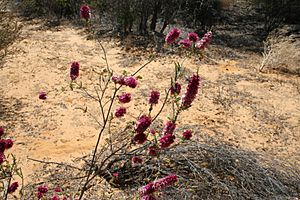Verticordia venusta facts for kids
Quick facts for kids Verticordia venusta |
|
|---|---|
 |
|
| Conservation status | |
| Scientific classification | |
| Genus: |
Verticordia
|
| Species: |
venusta
|
Verticordia venusta is a beautiful flowering plant that belongs to the myrtle family, called Myrtaceae. You can only find it growing naturally in the south-west part of Western Australia. This plant is a shrub that branches out widely. It has small, egg-shaped leaves and produces lovely pink to maroon flowers in spring and early summer.
Contents
What Does Verticordia venusta Look Like?
Verticordia venusta is a shrub that grows with many branches. It can reach a height and width of about 0.3 to 3 meters (1 to 10 feet). It usually has one main stem at its base. The leaves are shaped like an egg or are slightly oval, and they are about 3 to 4 millimeters (0.12 to 0.16 inches) long.
The flowers sometimes have a nice smell. They grow in groups that look like spikes. Each flower sits on a small stalk, about 1.5 to 2 millimeters (0.06 to 0.08 inches) long. The flowers open one after another, starting from the bottom. They are pale purple, pink, or maroon when they first open, and their color fades as they get older.
The part of the flower called the floral cup is shaped like a top. It is about 3 millimeters (0.12 inches) long and has ridges. It is smooth and has tiny green parts called appendages. The sepals, which are like small leaves under the petals, spread out and are about 4 to 5 millimeters (0.16 to 0.20 inches) long. They have 8 to 13 feathery edges.
The petals stand upright and are almost round. They are about 4 to 5.5 millimeters (0.16 to 0.22 inches) long and have small teeth around their edges. The style, which is a part of the flower's reproductive system, is about 5 millimeters (0.20 inches) long. It is curved and has tiny hairs near its tip. This plant flowers from September to January.
How Was This Plant Named?
The plant Verticordia venusta was first officially described by a scientist named Alex George in 1991. He described it from plants he found south of Manmanning. His description was published in a science journal called Nuytsia.
The second part of its scientific name, venusta, comes from a Latin word. It means "like Venus," "beautiful," or "lovely." This name was chosen because the plant looks very beautiful when it is in flower.
Where Does Verticordia venusta Grow?
This type of verticordia plant grows north-east of Perth in Western Australia. You can find it in areas between towns like Mullewa, Gunyidi, Dowerin, and Bencubbin. These areas are part of the Avon Wheatbelt and Geraldton Sandplains biogeographic regions. It usually grows in sandy soil, sometimes with gravel or clay, in areas with heath (low shrubs) and other shrubland plants.
Is Verticordia venusta Protected?
The Western Australian Government's Department of Parks and Wildlife has classified Verticordia venusta as "Priority Three". This means that not much is known about this plant, and it is found in only a few places. However, it is not in immediate danger of disappearing.
Growing Verticordia venusta in Gardens
It has been tricky to grow Verticordia venusta from cuttings (taking a piece of the plant and growing a new one). However, people have had success by grafting it onto another plant called Chamelaucium uncinatum. Grafting means joining parts of two plants so they grow as one.
When planted in a garden, Verticordia venusta usually takes a while to get established. But once it does, it is often quite strong and hardy. Sometimes, people even grow it in pots for several years.


